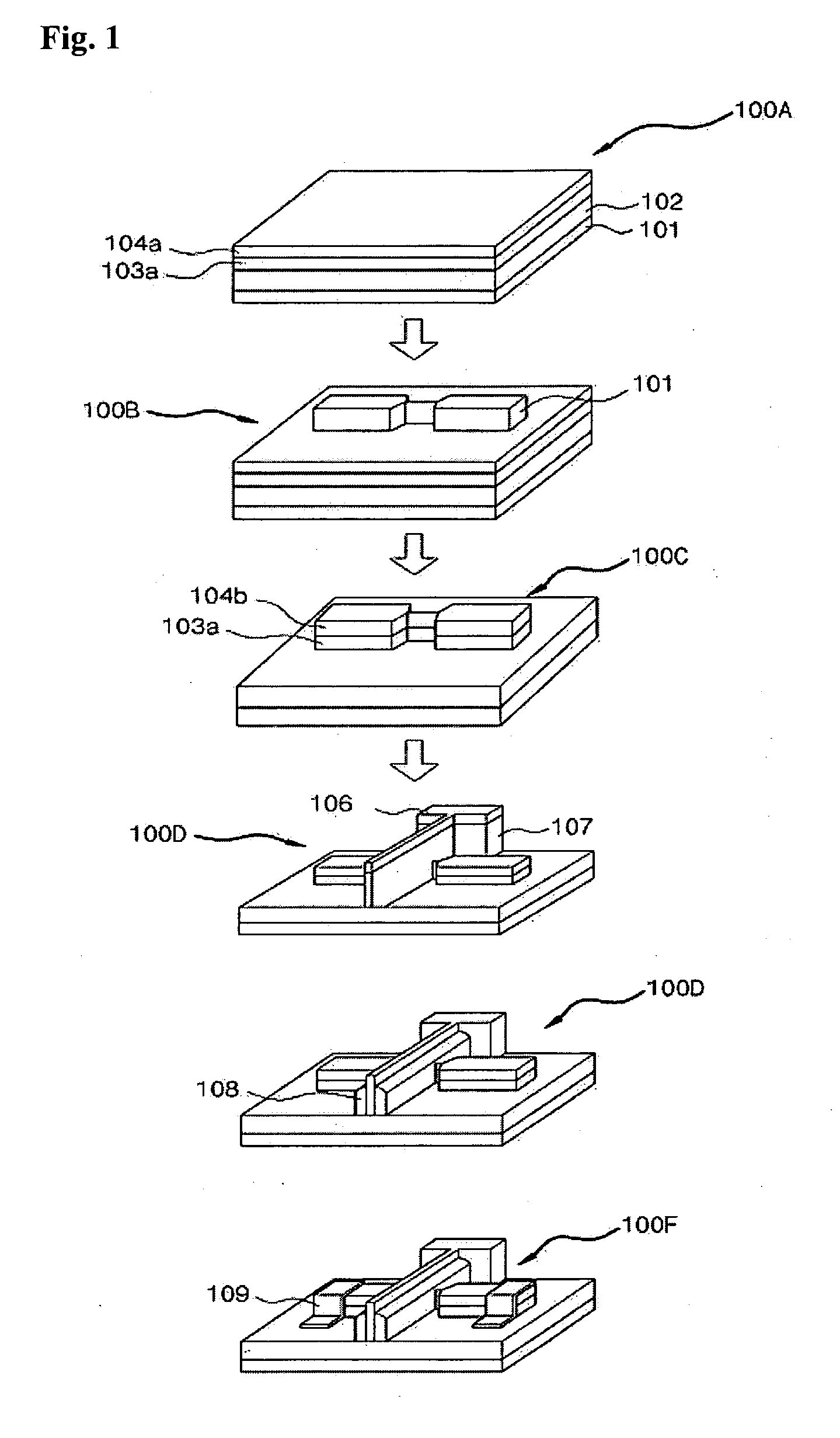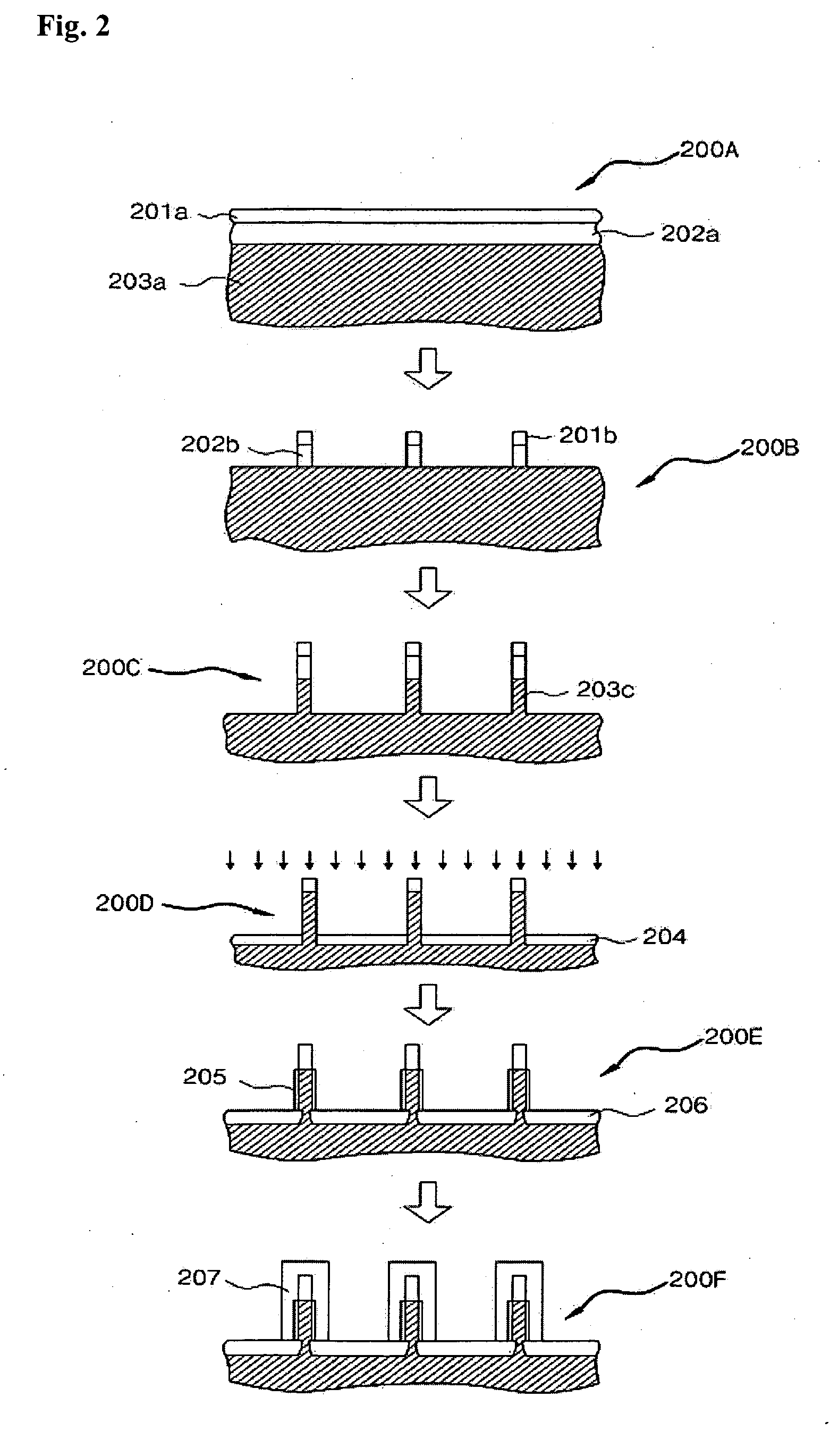Method for manufacturing field effect transistor having channel consisting of silicon fins and silicon body and transistor structure manufactured thereby
a technology of field effect transistor and silicon body, which is applied in the direction of basic electric elements, semiconductor devices, electrical devices, etc., can solve the problems of difficult to control the exact height of the silicon channel, complicated to correct the device channel width in the device layout, so as to achieve the effect of increasing the current value and simply correcting the channel width
- Summary
- Abstract
- Description
- Claims
- Application Information
AI Technical Summary
Benefits of technology
Problems solved by technology
Method used
Image
Examples
embodiment 1
[0058]FIG. 4a is a process perspective view sequentially showing a method for manufacturing a field effect transistor comprising a channel consisting of silicon fins and a silicon body.
[0059] First, an SOI substrate comprising a silicon substrate 401, a buried oxide film 402 and a silicon thin film 403 formed on the buried insulation film 402 is provided. On the silicon thin film 403, a hard mask 404 is formed which is made of a material which will not be etched in subsequent anisotropic or isotropic etching of the silicon thin film (400A).
[0060] In this step, the hard mask 404 may also be formed on a silicon bulk substrate instead of the SOI substrate comprising the silicon substrate 401, the burred oxide film 402 and the silicon thin film 403.
[0061] Then, the silicon thin film 403 is anisotropically etched using the mask pattern 404 as a mask to form a silicon fins 403 where a channel is to be formed, and a silicon pattern 403a where a source / drain region is to be formed. Also,...
embodiment 2
[0072] Embodiment 2 of the present invention is the same as Embodiment 1 except that, after conducting the step (400C) of etching the silicon body using the active mask 405 so as to isolate the source / drain region and the device from each other, the step (400B) of forming the silicon fins using the hard mask 400 is conducted. Accordingly, a drawing showing the second embodiment will be omitted herein.
[0073]FIG. 4b is an a-a′ cross-sectional view of the device manufactured by the method shown in FIG. 4a.
[0074] As can be seen in FIG. 4b, the silicon fins and the silicon body serve as a channel, the orientation of the silicon fins is (110), and the orientation of the silicon body is (100).
[0075] In the case of NMOS according to one embodiment of the present invention, a reduction in electric current by the mobility of electrons in the silicon fins having an orientation of (110) is compensated not only by the effect of an increase in the device channel width in the silicon body but a...
embodiment 3
[0077]FIG. 5 is a process cross-sectional view sequentially showing a method for manufacturing a field effect transistor having a channel consisting of silicon fins and a silicon body, according to Embodiment 3 of the present invention.
[0078] First, an SOI substrate comprising a silicon substrate 501, a buried oxide film 502 and a silicon thin film 503 on the buried oxide film 502 is provided (500A).
[0079] In this step, a silicon bulk substrate may also be used instead of the SOI substrate comprising the silicon substrate 501, the buried oxide film 502 and the silicon thin film 503.
[0080] Then, an oxide film 504 is formed on the silicon thin film 503 and etched and patterned using a mask so as to form portions where silicon fins are to be formed (500B).
[0081] In this step, other materials than the oxide film may also be deposited or grown on the silicon thin film 503 and then etched using a mask.
[0082] Next, selective epitaxial growth of silicon is used to form silicon fins 503...
PUM
| Property | Measurement | Unit |
|---|---|---|
| channel length | aaaaa | aaaaa |
| thickness | aaaaa | aaaaa |
| anisotropic | aaaaa | aaaaa |
Abstract
Description
Claims
Application Information
 Login to View More
Login to View More - R&D
- Intellectual Property
- Life Sciences
- Materials
- Tech Scout
- Unparalleled Data Quality
- Higher Quality Content
- 60% Fewer Hallucinations
Browse by: Latest US Patents, China's latest patents, Technical Efficacy Thesaurus, Application Domain, Technology Topic, Popular Technical Reports.
© 2025 PatSnap. All rights reserved.Legal|Privacy policy|Modern Slavery Act Transparency Statement|Sitemap|About US| Contact US: help@patsnap.com



